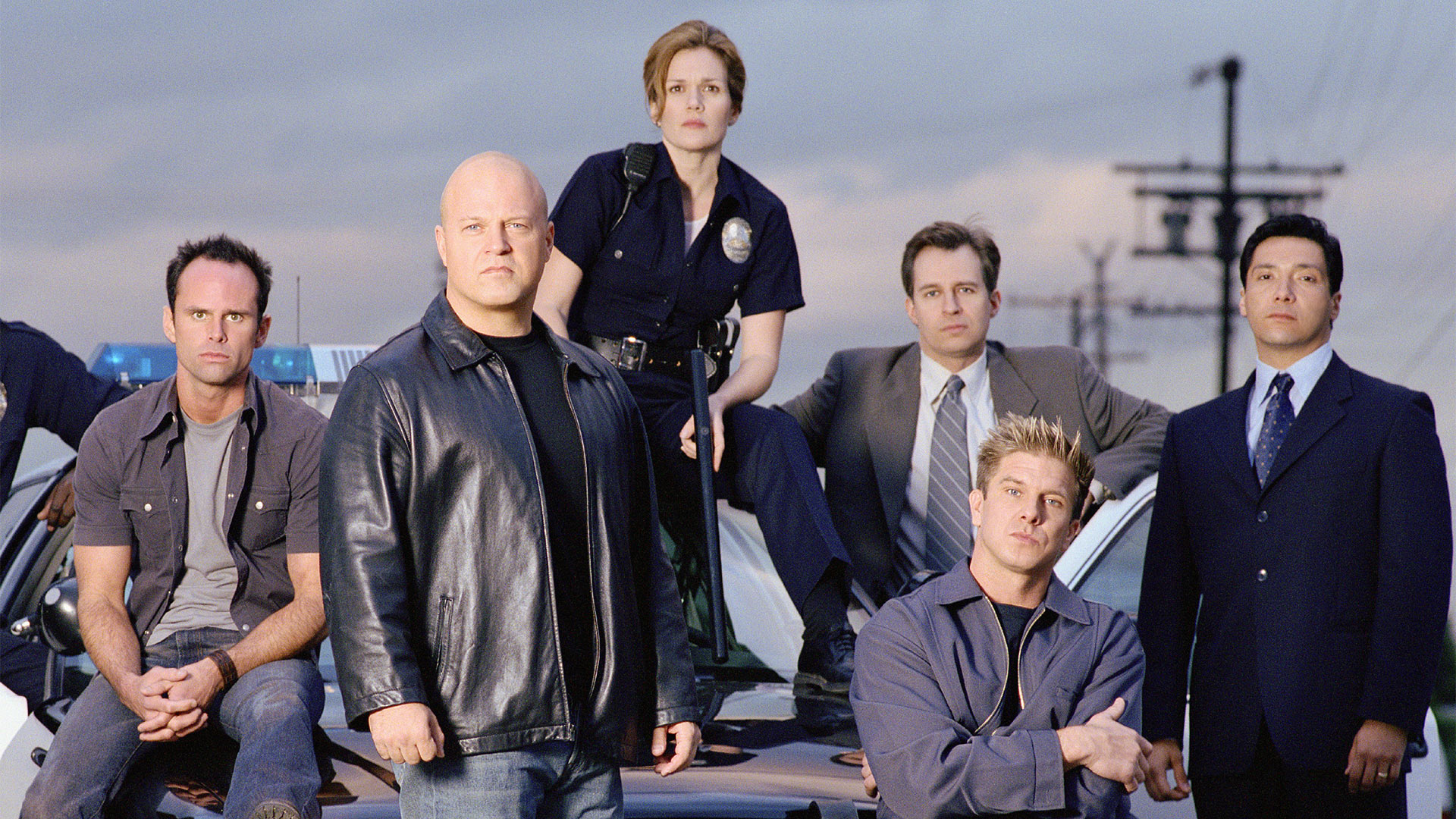The Role of a Showrunner
“Showbiz has one rule. The show must go on. And, the showrunner is the only position I can think of where ‘show’ is in that title. Your job as the showrunner is to make it happen,” Glen Mazzara emphasizes. The showrunner is responsible for the vision of the show and the logistics of bringing that vision to life, so they have “a relationship to the material that no one else has because the showrunner is going through every step of the chain.” The person in this unique position has to coordinate with many other departments, and sits at a midpoint. Above the showrunner are the “studio, network, IP, original IP, and fans, who are exerting pressure on you,” and below, you have “150 to 300 people hoping that you don’t screw up and they get fired.”
But how do you land this coveted position? According to Mazzara, the showrunner “is tasked by the studio, not the network, to run the show,” and it is “always a writer’s position.” However, “Very often people become showrunners because they’re successful writers,” but these talented writers don’t always have the management skills they need to step into this role. Because Mazzara was previously the manager of an emergency room, he was equipped with the proper skill set for running shows.
The showrunner must have the creative vision for the show and unite the writers under that vision so that they can all successfully create the series together. Mazzara reflects that the audience can get past imperfect plots but what keeps people interested in a show are the tone and the characters, so “the showrunners have a responsibility to protect the tone of the show.” To do this successfully, Mazzara feels that “emotionally I have to be a know-it-all; I have to have all the answers,” but a showrunner should also be collaborative and inspire people in the room to give their best work. Mazzara describes this aspect of showrunning as a lot of explaining, questioning, and listening.
The purpose of the writers’ room is to basically sit around a table and come up with ideas for stories.
Glen Mazzara
How to Succeed in a Writers’ Room
In the words of Glen Mazzara, “The purpose of the writers’ room is to basically sit around a table and come up with ideas for stories.”
What makes someone an ideal candidate for one of the spots in that room? When Mazzara creates a writers’ room for a show, he looks for people who are deeply passionate about the show that the showrunner is trying to make and not just looking for a good credit. The writers’ room is “the inner sanctum, the place that the showrunners will look for support so your key thing when you are becoming a staff writer is to support the showrunner, not to support what you think the show is.” He adds, “Many times staff writers think: what I need to do is to mine my personal experience, be supportive, be helpful, do research, that kind of stuff. No, you need to focus on what the showrunner wants you to write.” That, however, does not take away from how essential it is for writers to bring their own creativity to the process.
Mazzara believes that, “without a doubt, breaking the story is the single hardest part of writing”, but that it is also a place where writers can bring their own creativity and stand out. Instead of seizing this opportunity, he reflects that “ninety-nine percent of writers do not bring forward imaginative ideas. They either try to further the showrunner’s idea by one or two steps, or they fine-tune it, or the worst thing you could do in a writers’ room is be the logic police.” To avoid the negativity that being the “logic police” brings to the room, Mazzara has a rule: Do not knock something off the table without putting something else there. The tendency to pitch unimaginative ideas may come from a lack of confidence but Mazzara encourages new writers to “take big swings.” In the face of the many challenges of writing a TV show, he emphasizes the need to “trust the process; trust that it will get figured out” and “embrace the chaotic nature of breaking a story.”
Along similar lines, Mazzara stresses that “flexibility is just as key as imagination. Try different things in the writing and trust that you’re going to make the best decision.” Flexibility was key to landing his first writers’ room job. Recalling his pitch for the job, Mazzara explains that he had a bad panic attack during the interview. Instead of giving up, he took the interviewer’s advice of creating a bullet-pointed list of episode ideas, and he returned with thirty different pitches. While it may have been excessive, he got the job. Now, he looks for writers who can generate lots of story ideas. The writers’ room needs this because you are going to “burn through a lot of stories to get to the best possible story.” He suggests approaching idea generation from the lens of: “What do you love? What do you care about? What are those stories you want to tell? And then, how do you filter it through what you believe the showrunner is trying to do?”
Another thing that Mazzara values when putting together a team is a myriad of backgrounds. He asserts, “As we all look to transition into writing, we feel like we need to develop ourselves as a writer, and we forget about the other skills we bring to a project, so when I interview a writer …I’m looking for their life experiences. I’m looking for what they can offer.”

The Writing Process
“When a show is greenlit and goes into production, you have a problem,” claims Mazzara. “The problem is that you have a chaotic, creative, unstructured process of writing that has to fit a manufacturing model of budgets, schedules, locations, people driving in vans to get to places, and all of this stuff. A manufacturing model works when you’re making shoes, when you’re making all of the same things. If you’re making every individual episode, it’s crazy to do this, and we’re crazy when we write TV. We are crazy because all you have is problems, so what I need from my writing staff are solutions.”
So, how does it actually work? The first step is beating out the story. Mazzara teaches, “When you beat out a story everyone sits around the room, and you’re trying to generate ideas. You’re developing those ideas, and you’re putting them up on a board. You might be writing them on index cards, but you’re trying to structure a story.” There are various levels of organization that different rooms employ when beating their stories. Mazzara tends to like finding the story while writing, but other people like to plan it all out in advance.
The next stage is the outline stage. Outlines consist of a paragraph describing the different scenes. Though Mazzara doesn’t find the outline phase helpful (because outlines, unlike scripts, still live in the verbal world versus the visual one of TV), he still makes them because other writers use them. The outline then gets sent around to the non-writing producers, the studio, and the network who all provide feedback and notes on it. This is a good time to figure out if the episode is working or not. But it is important to “only take notes that you really believe in. You can’t take notes, and then say once someone doesn’t like it, ‘but so and so told me to change it.’ You can’t do that. Your name’s on the cover page.”
Once you’ve revised your outline and evaluated all of your notes, you can begin writing the actual script. Mazzara lays out a few different methods for this. “The traditional method of writing a script works like this: you have a group of writers in a writers’ room. Usually the showrunner or the creator will have written a pilot. They’ll probably also write the second episode, and then, the third episode comes up so you break that story and you send the writer off to write that episode. Then you break the next story and you send another writer off. Now you’re down two writers in your writers’ room, and you start getting diminishing returns because the stories are better when everybody’s looking at it.”
Mazzara is dubious about this method because the people who are writing outside the room are also discovering new things about the stories and “bringing in [new] information so the system starts to break down.” It can also break down on network shows for longer runs because the more experienced writers often leave the room to write first, so you are left with less experienced ones. Then, the writers have to come back, after being separated from the room, for the second round of scripts. They must begin breaking this new episode, often while they are still producing their first episode. This method of writing is sequential writing.
The purpose of the writers' room is to basically sit around a table and come up with ideas for stories.
Glen Mazzara Tweet
How to Succeed in a Writers’ Room
In the words of Glen Mazzara, “The purpose of the writers’ room is to basically sit around a table and come up with ideas for stories.”
What makes someone an ideal candidate for one of the spots in that room? When Mazzara creates a writers’ room for a show, he looks for people who are deeply passionate about the show that the showrunner is trying to make and not just looking for a good credit. The writers’ room is “the inner sanctum, the place that the showrunners will look for support so your key thing when you are becoming a staff writer is to support the showrunner, not to support what you think the show is.” He adds, “Many times staff writers think: what I need to do is to mine my personal experience, be supportive, be helpful, do research, that kind of stuff. No, you need to focus on what the showrunner wants you to write.” That, however, does not take away from how essential it is for writers to bring their own creativity to the process.
Mazzara believes that, “without a doubt, breaking the story is the single hardest part of writing”, but that it is also a place where writers can bring their own creativity and stand out. Instead of seizing this opportunity, he reflects that “ninety-nine percent of writers do not bring forward imaginative ideas. They either try to further the showrunner’s idea by one or two steps, or they fine-tune it, or the worst thing you could do in a writers’ room is be the logic police.” To avoid the negativity that being the “logic police” brings to the room, Mazzara has a rule: Do not knock something off the table without putting something else there. The tendency to pitch unimaginative ideas may come from a lack of confidence but Mazzara encourages new writers to “take big swings.” In the face of the many challenges of writing a TV show, he emphasizes the need to “trust the process; trust that it will get figured out” and “embrace the chaotic nature of breaking a story.”
Along similar lines, Mazzara stresses that “flexibility is just as key as imagination. Try different things in the writing and trust that you’re going to make the best decision.” Flexibility was key to landing his first writers’ room job. Recalling his pitch for the job, Mazzara explains that he had a bad panic attack during the interview. Instead of giving up, he took the interviewer’s advice of creating a bullet-pointed list of episode ideas, and he returned with thirty different pitches. While it may have been excessive, he got the job. Now, he looks for writers who can generate lots of story ideas. The writers’ room needs this because you are going to “burn through a lot of stories to get to the best possible story.” He suggests approaching idea generation from the lens of: “What do you love? What do you care about? What are those stories you want to tell? And then, how do you filter it through what you believe the showrunner is trying to do?”
Another thing that Mazzara values when putting together a team is a myriad of backgrounds. He asserts, “As we all look to transition into writing, we feel like we need to develop ourselves as a writer, and we forget about the other skills we bring to a project, so when I interview a writer …I’m looking for their life experiences. I’m looking for what they can offer.”

The Writing Process
“When a show is greenlit and goes into production, you have a problem,” claims Mazzara. “The problem is that you have a chaotic, creative, unstructured process of writing that has to fit a manufacturing model of budgets, schedules, locations, people driving in vans to get to places, and all of this stuff. A manufacturing model works when you’re making shoes, when you’re making all of the same things. If you’re making every individual episode, it’s crazy to do this, and we’re crazy when we write TV. We are crazy because all you have is problems, so what I need from my writing staff are solutions.”
So, how does it actually work? The first step is beating out the story. Mazzara teaches, “When you beat out a story everyone sits around the room, and you’re trying to generate ideas. You’re developing those ideas, and you’re putting them up on a board. You might be writing them on index cards, but you’re trying to structure a story.” There are various levels of organization that different rooms employ when beating their stories. Mazzara tends to like finding the story while writing, but other people like to plan it all out in advance.
The next stage is the outline stage. Outlines consist of a paragraph describing the different scenes. Though Mazzara doesn’t find the outline phase helpful (because outlines, unlike scripts, still live in the verbal world versus the visual one of TV), he still makes them because other writers use them. The outline then gets sent around to the non-writing producers, the studio, and the network who all provide feedback and notes on it. This is a good time to figure out if the episode is working or not. But it is important to “only take notes that you really believe in. You can’t take notes, and then say once someone doesn’t like it, ‘but so and so told me to change it.’ You can’t do that. Your name’s on the cover page.”
Once you’ve revised your outline and evaluated all of your notes, you can begin writing the actual script. Mazzara lays out a few different methods for this. “The traditional method of writing a script works like this: you have a group of writers in a writers’ room. Usually the showrunner or the creator will have written a pilot. They’ll probably also write the second episode, and then, the third episode comes up so you break that story and you send the writer off to write that episode. Then you break the next story and you send another writer off. Now you’re down two writers in your writers’ room, and you start getting diminishing returns because the stories are better when everybody’s looking at it.”
Mazzara is dubious about this method because the people who are writing outside the room are also discovering new things about the stories and “bringing in [new] information so the system starts to break down.” It can also break down on network shows for longer runs because the more experienced writers often leave the room to write first, so you are left with less experienced ones. Then, the writers have to come back, after being separated from the room, for the second round of scripts. They must begin breaking this new episode, often while they are still producing their first episode. This method of writing is sequential writing.
You have to trust yourself, trust the stories you want to tell.
Glen Mazzara
Instead of sequential writing, Mazzara prefers the method that show creator Frank Darabont used on The Walking Dead. This approach consists of four to eight weeks where the entire writing staff breaks all of the different episodes together. Then, they spend two to three weeks where each writer writes a script. This allows the writers to have the most creative force behind the break, and then, they can look at all of the scripts from a macro point of view and evaluate if the characters are growing enough and if the show is building in an engaging way.
Group writing—sometimes referred to as “Frankenstein writing”—is a third method that writers’ rooms utilize. It is often used as sequential writing begins to break down to help the room catch back up. In this method, after a script is broken, different writers tackle different sections over a couple of days; the writing is divided by pages, acts, or storylines. The final step is assembling the script, where the writer that the script is attributed to combs through it to make sure it all works. When discussing this method, Mazzara notes that, “Writers don’t like it because your name is on a script you haven’t written one hundred percent of.” That said, he acknowledges, “What’s good about it is you get the entire team invested in everything. You get the script quicker. If you’re like me, who likes to see the scripts, I like this.”
The last step of the writing process is fine-tuning the scripts and making sure there is continuity in the voice of the show. Be warned: to do this, the showrunner or one of the head writers might even “throw out the entire script, completely rewrite it, and keep your name on it.” Mazzara reflects, “I have written many, many scripts attributed to other writers.”



